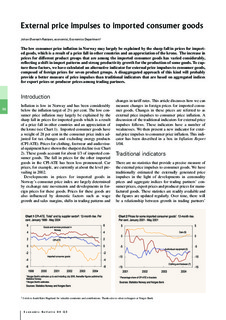| dc.contributor.author | Røstøen, Johan Øverseth | |
| dc.date.accessioned | 2018-07-05T07:40:07Z | |
| dc.date.available | 2018-07-05T07:40:07Z | |
| dc.date.issued | 2004 | |
| dc.identifier.issn | 0029-1676 | |
| dc.identifier.uri | http://hdl.handle.net/11250/2504440 | |
| dc.description.abstract | The low consumer price inflation in Norway may largely be explained by the sharp fall in prices for imported goods, which is a result of a price fall in other countries and an appreciation of the krone. The increase in prices for different product groups that are among the imported consumer goods has varied considerably, reflecting a shift in import patterns and strong productivity growth for the production of some goods. To capture these factors, we have calculated an alternative indicator for external price impulses to consumer goods, composed of foreign prices for seven product groups. A disaggregated approach of this kind will probably provide a better measure of price impulses than traditional indicators that are based on aggregated indices for export prices or producer prices among trading partners. | nb_NO |
| dc.language.iso | eng | nb_NO |
| dc.publisher | Norges Bank | nb_NO |
| dc.rights | Attribution-NonCommercial-NoDerivatives 4.0 Internasjonal | * |
| dc.rights.uri | http://creativecommons.org/licenses/by-nc-nd/4.0/deed.no | * |
| dc.title | External Price Impulses to Imported Consumer Goods | nb_NO |
| dc.type | Journal article | nb_NO |
| dc.subject.nsi | VDP::Samfunnsvitenskap: 200::Økonomi: 210::Samfunnsøkonomi: 212 | nb_NO |
| dc.source.pagenumber | 96-102 | nb_NO |
| dc.source.journal | Economic Bulletin | nb_NO |
| dc.source.issue | 3/2004 | nb_NO |

